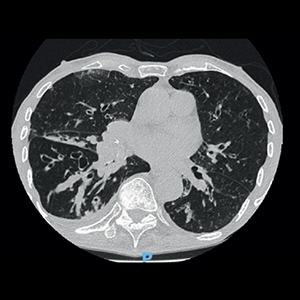Acute and long-term management of severe bronchiectasis with high flow nasal therapy: a case report

All claims expressed in this article are solely those of the authors and do not necessarily represent those of their affiliated organizations, or those of the publisher, the editors and the reviewers. Any product that may be evaluated in this article or claim that may be made by its manufacturer is not guaranteed or endorsed by the publisher.
Accepted: 1 August 2022
Authors
Bronchiectasis (BE) is a long-term, chronic lung condition featured by widened and scarred airways. These can alter the physiological mucociliary clearance, making it difficult to clear mucus and microorganisms, leading to frequent exacerbations. High flow nasal therapy (HFNT) is a noninvasive respiratory support that delivers heated and humidified gas eventually enriched with oxygen, through a nasal cannula. Humidification is crucial for adequate airways mucociliary clearance, improving ciliary function and consequently reducing airways inflammation and recurrent infections. HFNT has been mostly used in patients with acute hypoxemic respiratory failure and in selected patients with chronic respiratory failure due to COPD. Still, evidence about its use in acute and long-term home setting in patients with clinically relevant BE are lacking. We report a case of severe widespread BE, already on top medical therapy and pulmonary rehabilitation, still suffering from difficult mucus expectoration and recurrent exacerbations, who has been additionally treated with HFNT, both in hospital and domiciliary, reporting significant improvements on relevant clinical and patient-centered outcomes. Thus, HFNT may confer additional benefits as an add-on treatment of patients with severe BE and respiratory failure.
How to Cite

This work is licensed under a Creative Commons Attribution-NonCommercial 4.0 International License.






